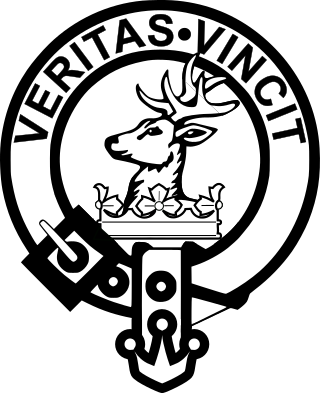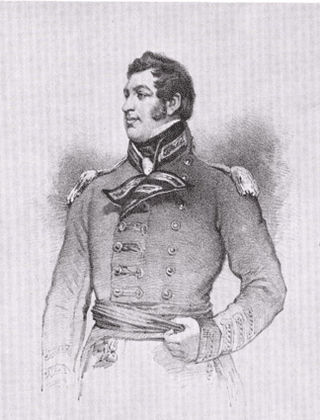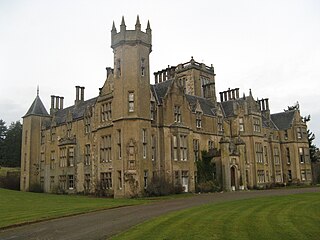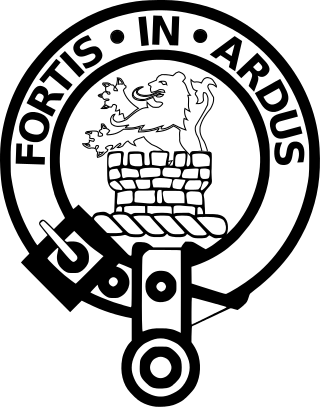Related Research Articles
Hepburn is a family name of the Anglo-Scottish border, that is associated with a variety of notable people, eponyms, places, and things. Although commonly a Scottish name, its origins lie to the south of the border in the north of England. Specifically, the name is thought to have derived from Hepburn or Hebron in Northumberland or Hebburn in Tyne and Wear. The origins of the name are suggested to be the same as that of Hebborne from the Old English words heah ("high") and byrgen. Alternatively it could mean something along the lines of "high place beside the water", as the word burn is a still widely used in Northumbrian and Scots for stream.

Clan Keith is a Highland and Lowland Scottish clan, whose Chief historically held the hereditary title of Marischal, then Great Marischal, then Earl Marischal of Scotland.

John Arbuthnott, 8th Viscount of Arbuthnott DL FRSE was a Scottish peer and soldier. Known as "the rich Lord" he built the bridge in front of Arbuthnott House, Kincardineshire. He was the first member of the family who consistently spelled his name "Arbuthnott" rather than "Arbuthnot".

General George Duncan Gordon, 5th Duke of Gordon,, styled Marquess of Huntly until 1827, was a Scottish nobleman, soldier and politician and the last of his line.

James Graham, 3rd Duke of Montrose, KG, KT, PC, styled Marquess of Graham until 1790, was a Scottish nobleman and statesman.

James Ian Keith, 12th Earl of Kintore DL, known as Viscount Stonehaven between 1941 and 1974, and Chief of Clan Keith from 1974 on, was a Scottish peer and nobleman.

Colonel Francis William Ogilvie-Grant, 6th Earl of Seafield, known for most of his life as Francis William Grant, was a Scottish nobleman, soldier and politician. He is numbered as the 25th Chief of Clan Grant.

Lord Adam Gordon was a Scottish career army officer, achieving the rank of general, and a younger son of Alexander Gordon, 2nd Duke of Gordon, and Lady Henrietta Mordaunt.

Ury House is a large ruined mansion in Aberdeenshire, Scotland, built in the Elizabethan style in 1885 by Sir Alexander Baird, 1st Baronet. It is situated on the north-east coast about 1 mile (1.6 km) north of Stonehaven in the former county of Kincardineshire.
Sir Patrick Hepburn of Waughton and Luffness was a Scottish laird and notable Covenanter from East Lothian. In 1639-1641 Sir Patrick was a member for Haddingtonshire in the Scottish Parliament.

John Smith was a Scottish architect. His career started in 1805 and he was appointed as the official city architect of Aberdeen in 1807, the first person to hold this post. Together with Archibald Simpson, he contributed significantly to the architecture of Aberdeen, and many of the granite buildings that gave the city the nickname "The Granite City" or also "The Silver City" are attributed to them.

Cowton Burn is a stream that rises in the Mounth, or eastern range of the Grampian Mountains, on some of the northwest slopes of the Durris Forest west of Netherley, Aberdeenshire, Scotland. The Grid Reference for the headwaters is NO 925 823); Cowton Burn is a tributary to the Cowie Water. The Cowton Burn is crossed by the A957 road slightly northwest of Rickarton House.

Rickarton House is a 19th-century country house in Kincardineshire, Scotland. It lies approximately three-and-a-half miles northwest of Stonehaven in the former county of Kincardineshire. The house is situated on the north banks of the Cowie Water slightly upstream of the confluence with Cowton Burn. Rickarton is a category B listed building. Rickarton House was constructed in the first decade of the 19th century for William Rickart Hepburn. He commissioned the City Architect of Aberdeen, John Smith, to undertake the work.

Colonel Robert Rickart Hepburn of Keith was Member of Parliament for Kincardineshire 1768–1774.

Lieutenant-General Sir Love Parry Jones-Parry KH was a British Army officer, politician and later a High Sheriff. He was the son of Thomas Jones, and after his father acquired an estate at Madryn Castle from his cousin Margaret Parry in 1807 took Parry as an additional surname.
David Graeme was a British officer in the Scots Brigade, diplomat and courtier, responsible for carrying George III's proposal of marriage to Charlotte of Mecklenburg-Strelitz.
James Ochoncar Forbes, 17th Lord Forbes (1765–1843), was a Scottish soldier and peer. He was the eldest son of James Forbes, 16th Baron Forbes, by Catherine, only daughter of Sir Robert Innes, baronet, of Orton. The lands of Forbes, Aberdeenshire, still in their possession, have been held by this family since the reign of William the Lion (1165–1214).
General Henry Renny (1815–1900) was a British Army officer who was the 24th General Officer Commanding, Ceylon.
Lieutenant-General James Scott, of Commieston, Kincardine, was a British Army officer and politician who sat in the House of Commons from 1713 to 1734. He served in the Scots Guards for 51 years

Clan Middleton is a Lowland Scottish clan. It is recognised as such by the Court of the Lord Lyon, but as it does not currently have a chief recognised by the Lord Lyon King of Arms it is considered an armigerous clan.
References
- ↑ Andrew Jervise, James Anderson, William Alexander, John Grant Michie, Epitaphs & Inscriptions from Burial Grounds & Old Buildings in the North of Scotland, Published 1875, Edmonston and Douglas
- ↑ The Scots Magazine, Volume 69